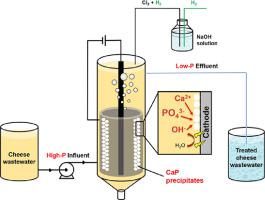Water Research ( IF 12.8 ) Pub Date : 2021-05-05 , DOI: 10.1016/j.watres.2021.117199 Yang Lei , Zhengshuo Zhan , Michel Saakes , Renata D van der Weijden , Cees J. N. Buisman

|
Phosphorus (P) is an irreplaceable element, playing a vital role in living organisms, yet has limited earth reserves. The possibility of P recovery from wastewaters by electrochemically-induced calcium phosphate precipitation (ECaPP) was demonstrated previously. The current study presents a novel scalable prototype consisting of a column-shaped electrochemical reactor, a tubular stainless-steel cathode, and a Pt coated Ti anode. The adhesion of solids to the cathode, important for product recovery, was shown not to be negatively impacted by electrodes’ vertical placement. The influence of current (density), hydraulic retention time (HRT), and initial phosphate concentration in this prototype were examined under continuous flow operation. The system accomplished the highest P removal rate (1267 mg/day) at 1.5 d HRT and 800 mA in treating undiluted cheese wastewater with 48.5 kWh/kg P. Moreover, the prototype showed high stability and efficiency (> 50%) over 173 days of continuous operation without performing maintenance. After turning off the current (0 mA), the system realized a surprising P removal jump up to 97.3%, revealing the delayed diffusion of hydroxide ions by the deposition layer. The calculation of CAPEX and OPEX of ECaPP in treating 100 m3 cheese wastewater per week indicates that the ECaPP plant can realize net-positive from the 12th year. The recovered solids have relatively high P content (> 9wt%) and insignificant contamination of heavy metals. Overall, the proven suitability of the scalable prototype can pave the way towards the actual adoption of the ECaPP process.
中文翻译:

使用管状不锈钢阴极电化学回收废水中的磷,以实现可扩展的长期运行
磷(P)是不可替代的元素,在生物体中起着至关重要的作用,但地球储量却有限。从废水中回收P的通过的可能性Ë lectrochemically诱导CA lcium p hosphate p沉淀(ECaPP)之前已得到证明。当前的研究提出了一种新颖的可扩展原型,该原型包括圆柱状电化学反应器,管状不锈钢阴极和涂有Pt的Ti阳极。固体对阴极的附着力(对于产品回收非常重要)显示出不会受到电极垂直放置的负面影响。在连续流动操作下,检查了该原型中电流(密度),水力停留时间(HRT)和初始磷酸盐浓度的影响。该系统在1.5 d的HRT和800 mA的条件下,以4.5 kWh / kg的P处理未稀释的干酪废水时,实现了最高的P去除率(1267 mg / day)。此外,该原型在173天内显示出高稳定性和效率(> 50%)。无需维护即可连续运行。关断电流(0 mA)后,系统实现了令人惊讶的P去除率跃升至97.3%,这揭示了沉积层中氢氧根离子的延迟扩散。ECaPP处理100 m的CAPEX和OPEX的计算3,每周奶酪废水表明ECaPP工厂可以实现从12净正日的一年。回收的固体具有较高的P含量(> 9wt%)和对重金属的微小污染。总体而言,可扩展原型的经验证的适用性可以为ECaPP流程的实际采用铺平道路。


























 京公网安备 11010802027423号
京公网安备 11010802027423号